Technologies
I Upgraded to an iPhone 15 Pro Max From an 11. Here’s What Happened
Commentary: Why I jumped from my old iPhone to the newest, priciest model — and why I don’t regret it.

I was so confident that I wanted an iPhone 15 that I told the internet I was buying one before it was even announced. It’s a bold claim, I know. And I kept my word and upgraded from my 3-year-old iPhone 11 (I bought it in 2020) to the iPhone 15 Pro Max, my first Pro Apple phone ever.
At first, my decision to get an $1,199 iPhone 15 Pro Max that is bigger, heavier and much more expensive than my iPhone 11 might seem impulsive. But I guarantee it was anything but. And you might wonder why I opted for Apple’s most expensive phone instead of the $999 15 Pro that’s closer in size to the iPhone 11, or the $799 iPhone 15 which is more of a direct descendant from the 11. For me, it came down to the 15 Pro Max’s cameras. Let me explain.
Unprecedented 5x optical zoom
The 15 Pro Max has a 5x optical zoom, which is unheard-of for the iPhone and a major upgrade from my no zoom iPhone 11. The new telephoto camera is what ultimately convinced me to buy the 15 Pro Max. I mean, take a look at the photo evidence.
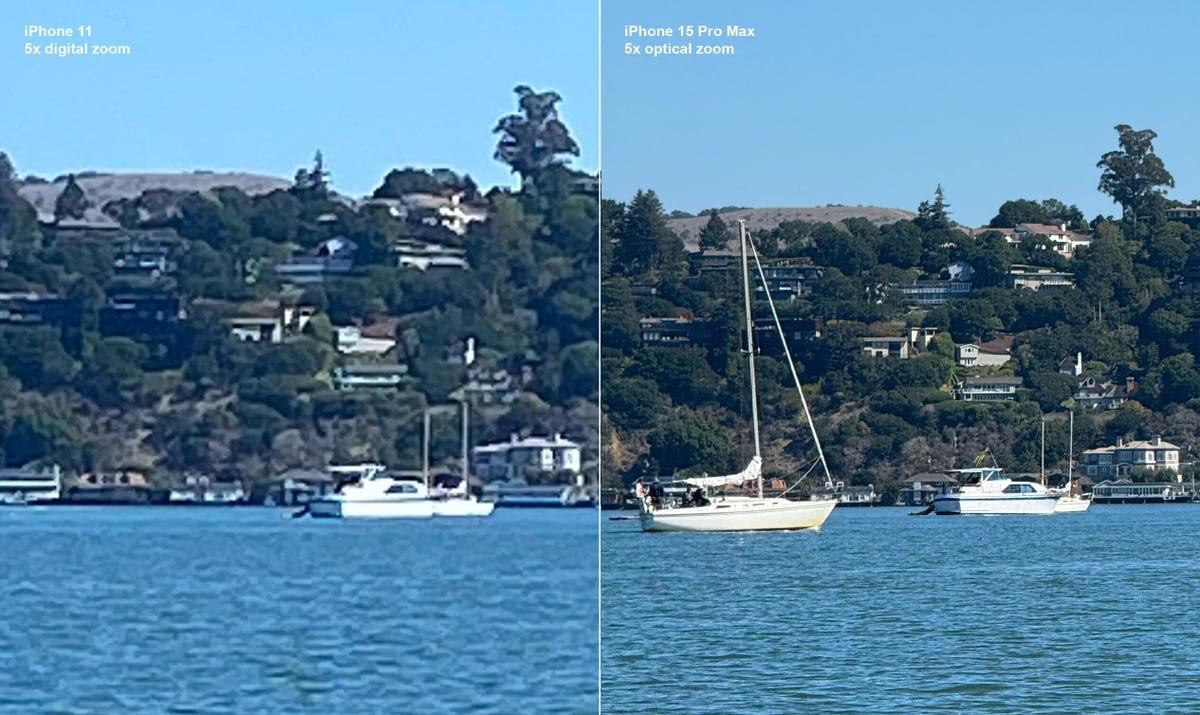

I played tourist for the day in San Francisco and took the photos below at the Golden Gate Bridge. I set the 15 Pro Max to 5x optical zoom and used the 11’s 5x digital zoom. I can’t believe the 15 Pro Max caught details like the panels on the bridge, and even the windows on the Salesforce Tower miles away in the background. Colors also appear truer-to-life in the 15 Pro Max’s photo. The Golden Gate Bridge’s iconic orange vermilion-colored paint really comes through in the 15 Pro Max image below.
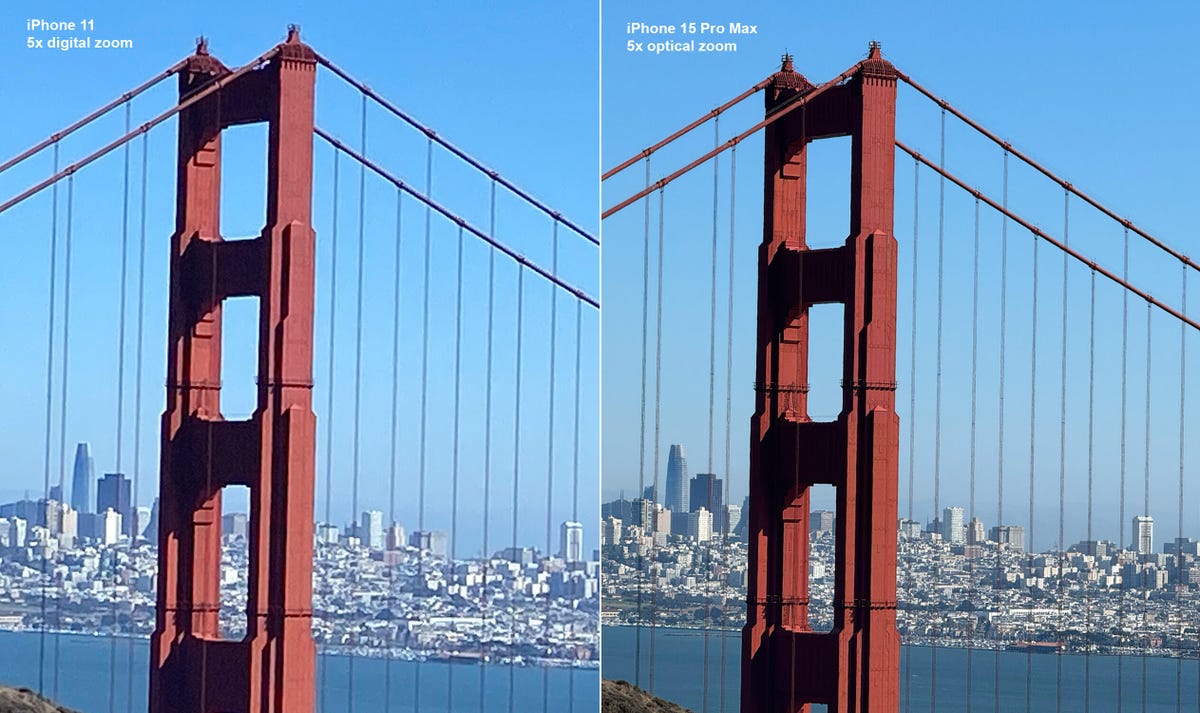

I like using the 5x optical zoom to record videos too, especially at concerts. The last artist I saw was Labrinth at Pier 80 during the Portola Music Festival in San Francisco. The 15 Pro Max videos I recorded during the concert looked so good I might as well have told everyone I was at the barricade, even though I was actually a few rows behind it. I couldn’t record anything remotely as good with my old iPhone 11. You can see my 5x zoom concert recordings in the video at the top of this page.
Brand-new action button (plus other features I don’t use enough)

The 15 Pros have swapped the classic mute switch for a brand-new action button. You can still use it to silence your phone, but you can also set it to do other things, like open the camera. (That’s what mine does.) When I saw the action button announced, I thought I’d use it a lot, but I’ve only used it a couple of times now that I actually have it. I’ll probably just switch it back to the mute function.
There are other 15 Pro Max features that are even more hyped like the always-on display and the Dynamic Island that I likewise found less useful once I tried them. I have poor self-control when it comes to my smartphone and seeing the screen even slightly lit makes me want to scroll. So I’ll probably turn off the always-on display so I have one less temptation to pick up my iPhone when I should be doing something else.
And while I told the internet how cool I thought the Dynamic Island looked, I’m walking that statement back. The Dynamic Island gets in the way of doing things I’m used to, like tapping the top of the screen to scroll up. On my iPhone 11, a tap on the top center of the screen brings the webpage or social feed I’m scrolling immediately back to the beginning. But on my 15 Pro Max, I need to tap just to the side of the Dynamic Island to trigger the same shortcut. This is going to take some getting used to. Also, when I try to use the Dynamic Island for things like changing songs, I end up accidentally closing it.
Titanium vs. aluminum

The iPhone 11 has an aluminum frame and weighs 6.84 ounces (194 grams), while the 15 Pro Max has a snazzy new titanium frame and weighs 7.81 ounces (221 grams). The titanium sides look and feel nice, but because I always have a case on my phone, they’re not a game-changer.
You also may have seen some titanium durability tests going viral. They made me a bit anxious. It’s worth keeping in mind that the people making these videos are pushing the iPhone 15 Pro Max to its limit. None of my CNET colleagues who have a 15 Pro or Pro Max have had any issues with the phone’s durability. But remember I’m coming from an iPhone 11 which, when CNET put it through a series of brutal drop tests, came through without a crack.
We got USB-C!

The iPhone 15 lineup swapped the Lightning charging port for a USB-C port, which is a big deal because it’s been over a decade since Apple last changed the charging port. USB-C is an industry-standard that can charge multiple devices, not just the iPhone.
So far, I’m a big fan. It was kind of annoying to have to switch out the Lightning aux cord and charger in my car. But because I already have so many USB-C cords lying around the house from devices like my MacBook Pro and Nintendo Switch, the transition has been easier than the one from the 30-pin to Lightning in 2012. I love only needing to have one cord at my desk that can charge both my laptop and my phone.
Battery: Is it giving ‘Pro Max’?
Apple says the 14 and 15 Pro Max iPhones offer up to 29 hours of video playback. But to be honest, I was not getting «Pro Max» battery life when I first got my new phone. I’d unplug it at 100% around 10 a.m. and it would be at about 30% by around 3:30 p.m. I had to limit my usage to get through the day on a single charge, which isn’t something I’ve ever experienced with a new (even non-Pro) iPhone. This is despite the fact that both the iPhone 15 Pro and Pro Max beat both the 14 Pro and Pro Max, as well as most Android phones, in CNET’s battery tests.
I was concerned, so I took a trip to the Genius Bar. I originally transferred my data wirelessly by placing my iPhone 11 next to my new 15 Pro Max. But Apple recommended I restore the 15 Pro Max to factory settings and transfer the old data from my computer. I was told if that didn’t fix things – which it didn’t – a future update probably would. A little under two weeks later, iOS 17.0.3 came out and fixed the problem. The software update also fixed a problem in iOS 17 that caused iPhones to overheat. After this experience, I probably won’t buy a new iPhone during launch week again.
How’s my battery doing today? I can get through a full day on a single charge, but I do need to plug it back in at night. I was honestly expecting a bit more from a Pro Max battery. It would be nice not to have to plug in my iPhone at night. But then I took a look at how much I actually use my phone. It turns out my daily average is 10 and a half hours a day, which is absolutely horrendous. And to be fair, even when my iPhone 15 Pro Max battery was struggling, it was still much better than the one on my iPhone 11, which would be at 30% by around 1 p.m. each day.
Thank goodness for macro mode
I’ve been having so much fun playing with Macro mode. This is a feature exclusive to Pro iPhones and I really didn’t realize what I was missing out on. My iPhone 11 can’t take macro photos. I’ve had a lot of fun taking creative shots in nature. Below are side-by-side photos of the underside of a leaf with Macro mode on my iPhone 15 Pro Max and without it on my iPhone 11.
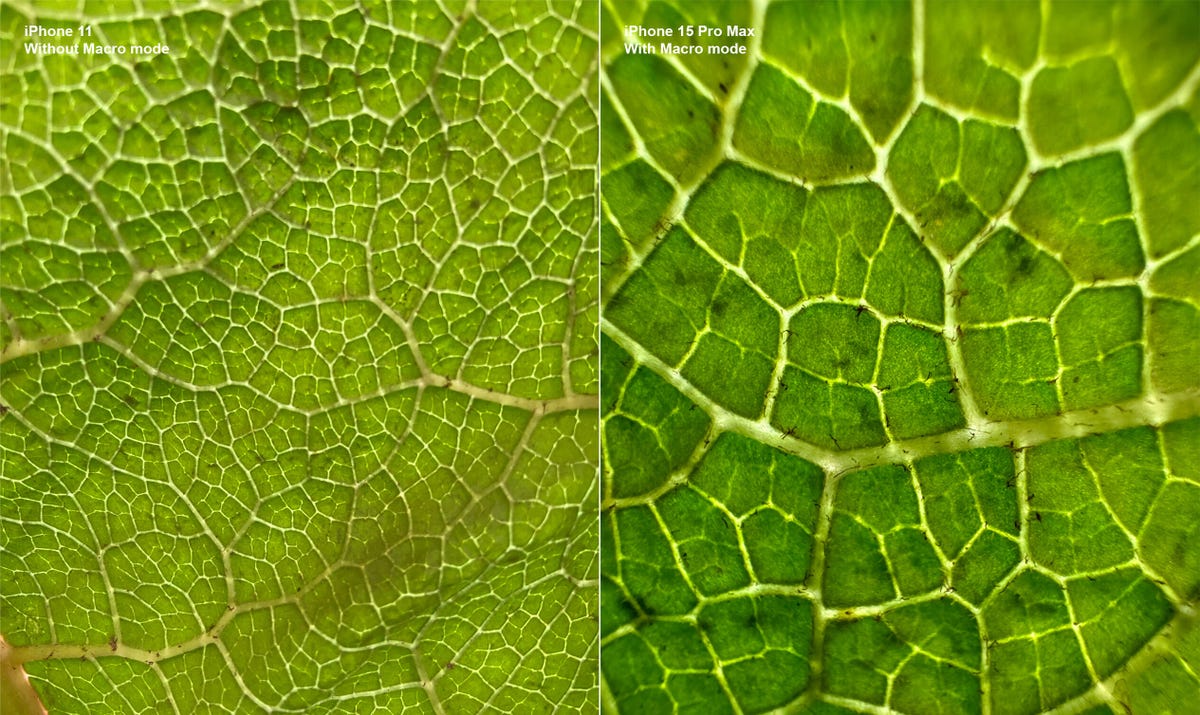
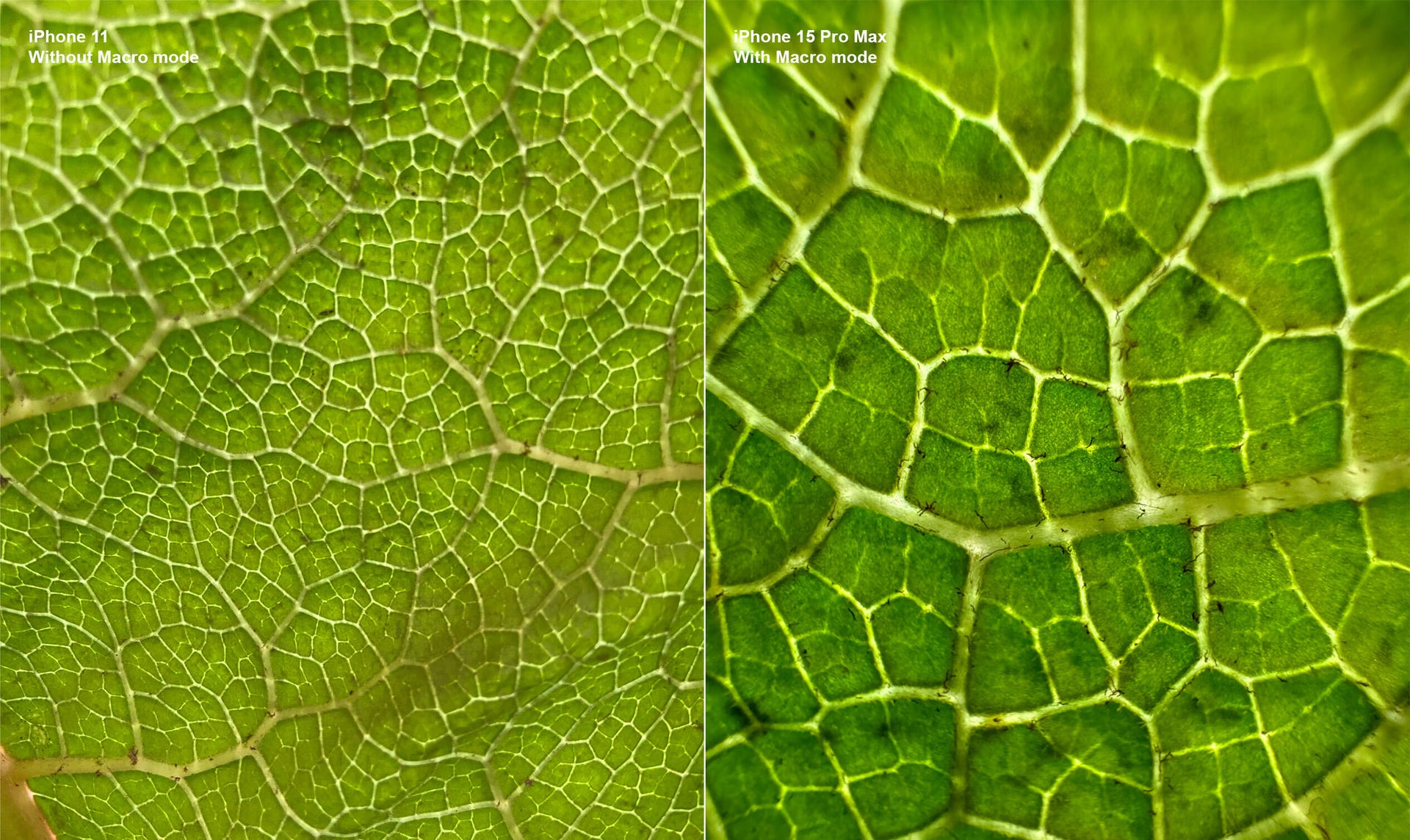
I use this feature to take pictures of my food because, as the saying goes, the phone eats first. Macro mode actually saved me from ingesting a bug in my pasta. While the iPhone 11 got pretty close to my lunch before losing focus, the 15 Pro Max got even closer and caught something crawling. So thanks Macro mode, because without you, I would’ve eaten that bug.

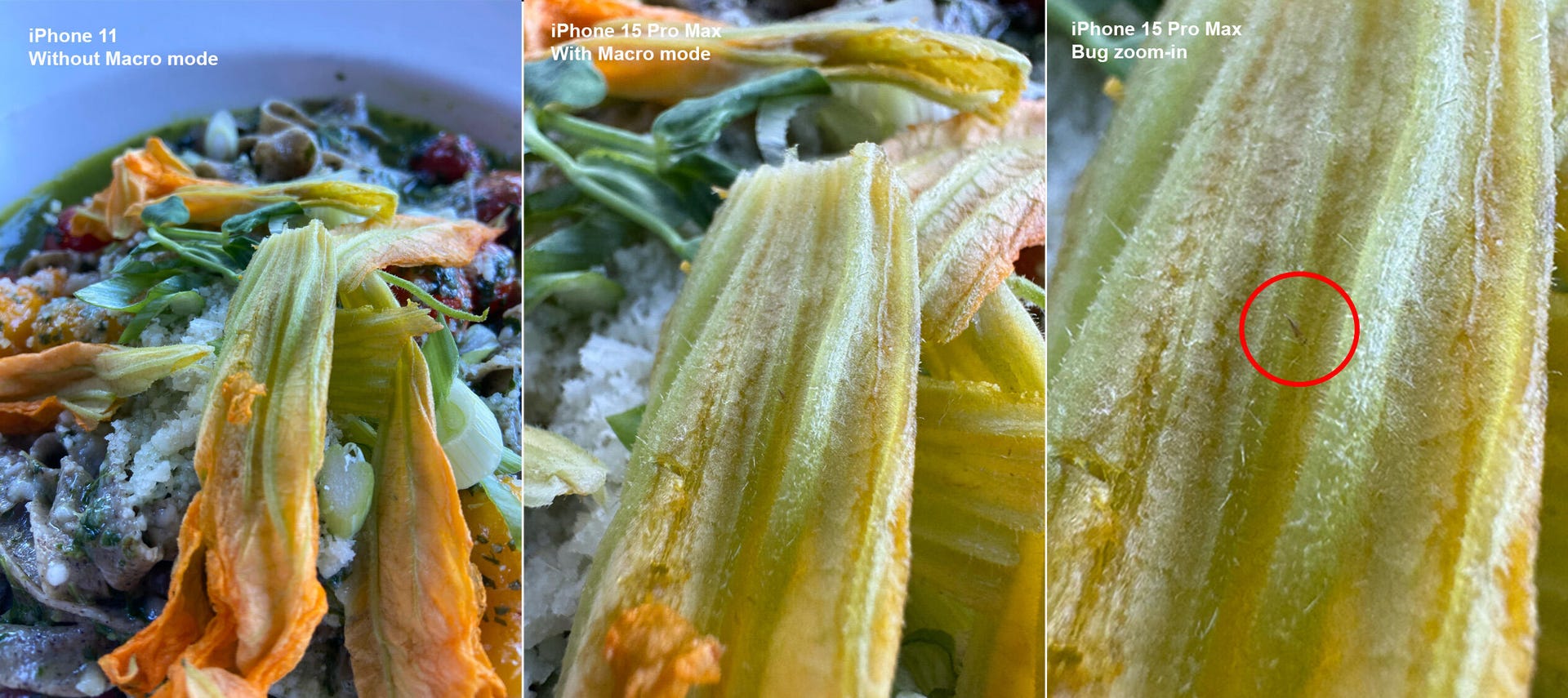
Next-level night mode on the 15 Pro Max
How about taking photos in lighting that’s less than ideal? Here are some shots of my friend and CNET colleague, Abrar Al-Heeti, taken at a restaurant in low-light.
Both of these photos were taken with Night mode, but being able to use it with 15 Pro Max’s Portrait mode takes low-light snaps to the next level.


I also find that 15 Pro Max Night mode photos are generally brighter and more detailed than those from the iPhone 11. For example, the knitting in Abrar’s sweater is clearer in the 15 Pro Max photo below.
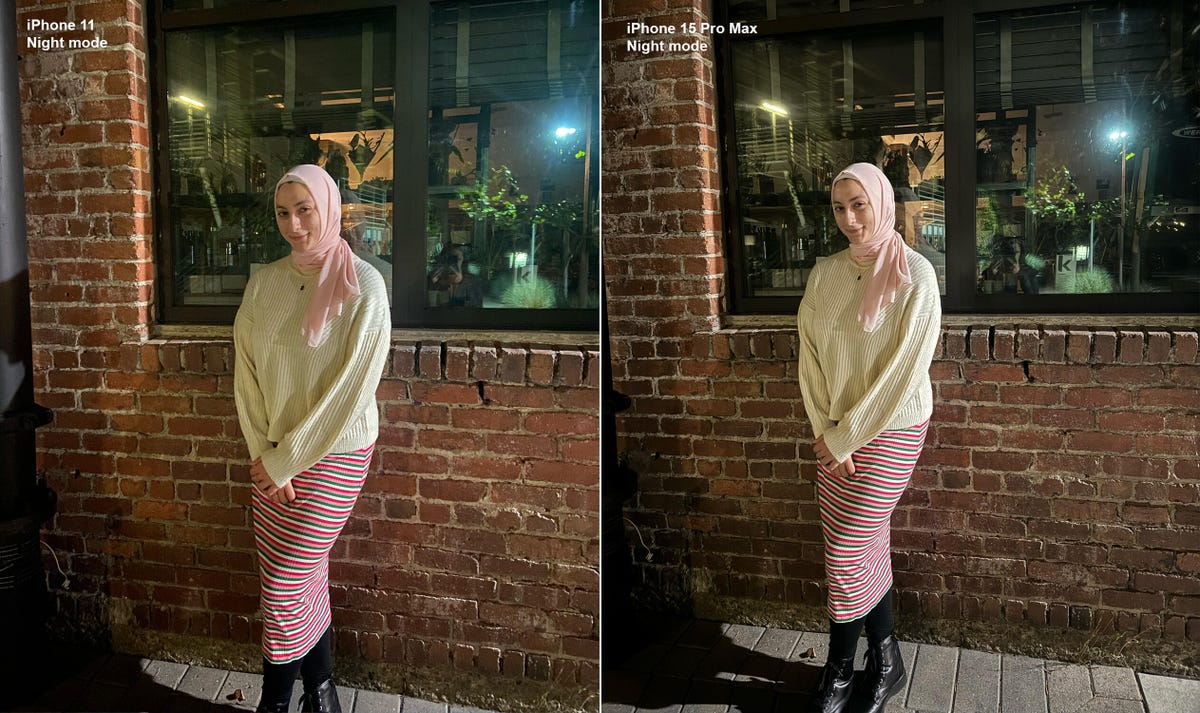
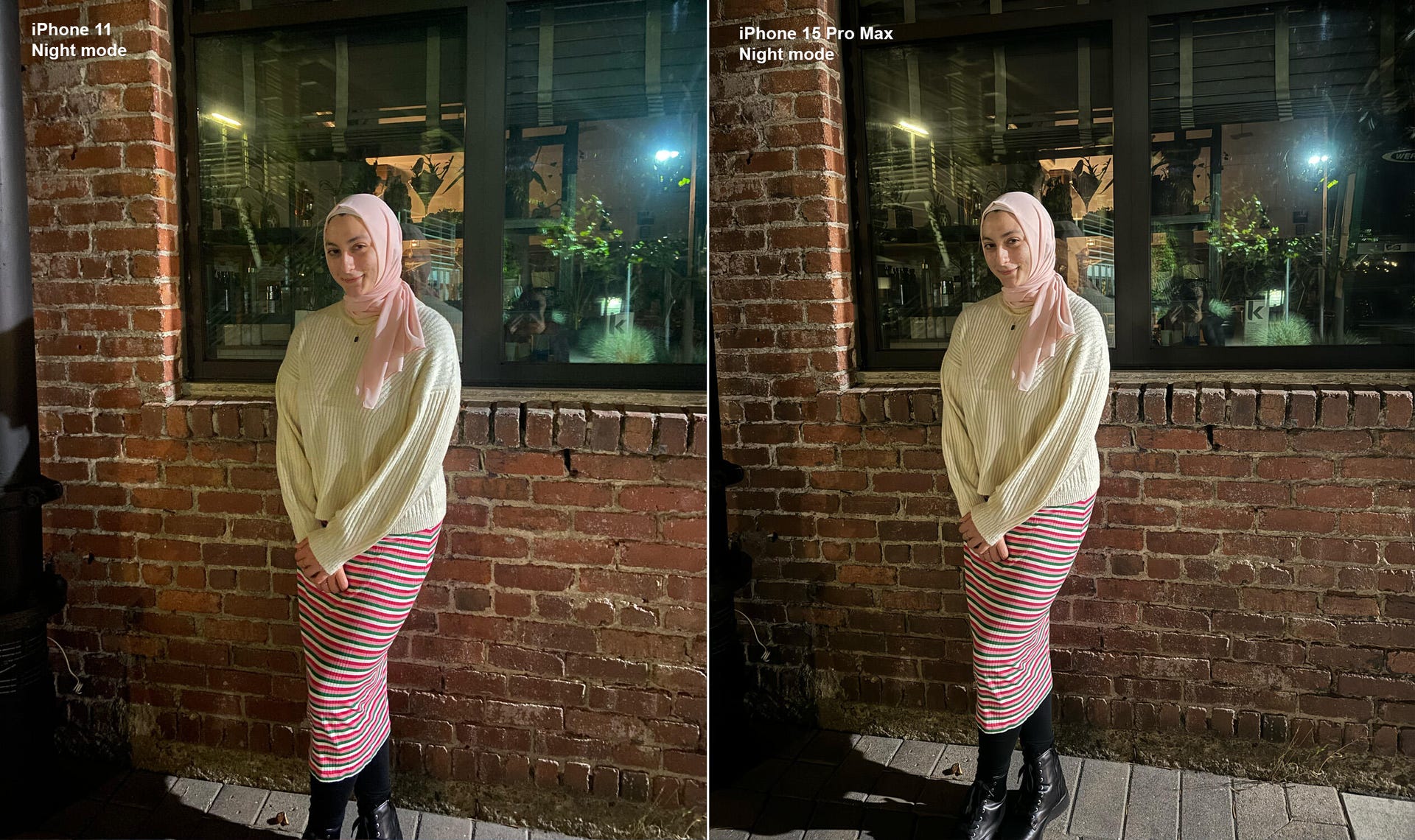
More portrait flexibility
I love that all of the iPhone 15s let you take Portrait mode photos of a person, cat or dog and change which subject is in-focus after a photo’s been taken. But changing the focus isn’t always perfect.
Take the photo below of myself, Abrar and our friend and CNET colleague, Viva Tung. When I change the focus to Viva, it blurs the edges of her sunglasses a bit, but generally works pretty well. But when I try to change the focus to Abrar, Viva’s still in focus, too.
To be fair, Apple does say not to have the subject you’re trying to have in-focus too far away from the camera, so maybe that’s the issue here. Overall, even though this feature isn’t seamless, it’s still fun to play around with — and I do appreciate the extra portrait flexibility. On my iPhone 11, I can’t change the focus in any of the photos I took.
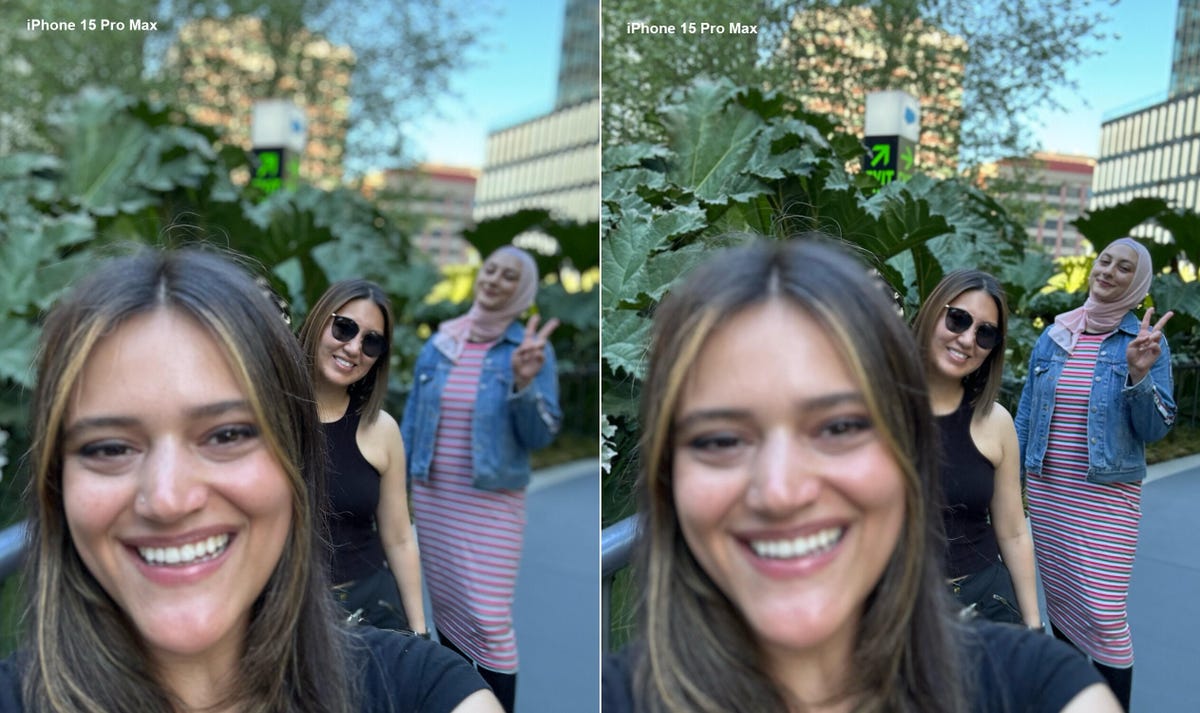
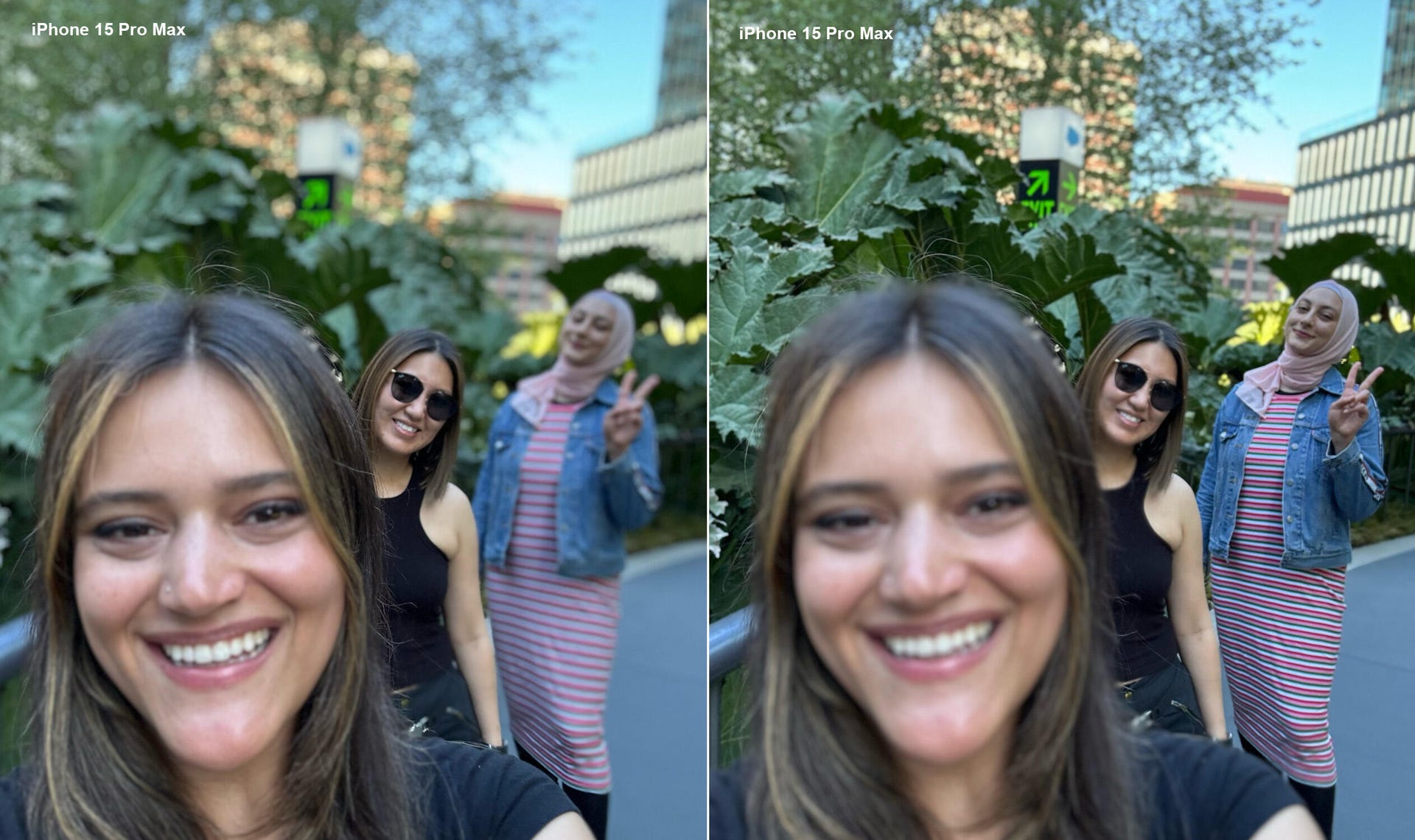
I’m also a big fan of Cinematic and Action modes for video. Cinematic mode blurs the background and makes video look so professional. And Action mode makes my shaky filming look nice and smooth. But to see what I’m talking about, you’ll have to watch the video above.
Is going Pro worth it?
I already told you that the camera alone made the iPhone 15 Pro Max worthwhile for me. Aside from the 5x optical zoom, my favorite camera features were things I could’ve gotten on the 15 Pro, like Macro mode, or on the regular 15, like Cinematic mode. So if a 5x optical zoom isn’t important to you, I’d recommend considering one of those other models, or even an older iPhone.
I was also surprised that features that sounded so cool on paper, like the Dynamic Island and the Action button, weren’t big draws for me once I actually tried them.
I’m interested to see how long the 15 Pro Max lasts because it was so expensive. I splurged because I was excited about that 5x optical zoom and hopeful this phone will last longer than any of my previous iPhones, including my beloved iPhone 11.
Technologies
Can Chemicals Turn My Orange iPhone 17 Pink? Here’s What I Found Out
There are reports that some cosmic orange iPhone 17 Pro handsets are turning pink. I threw chemicals at my iPhone to see what would happen.
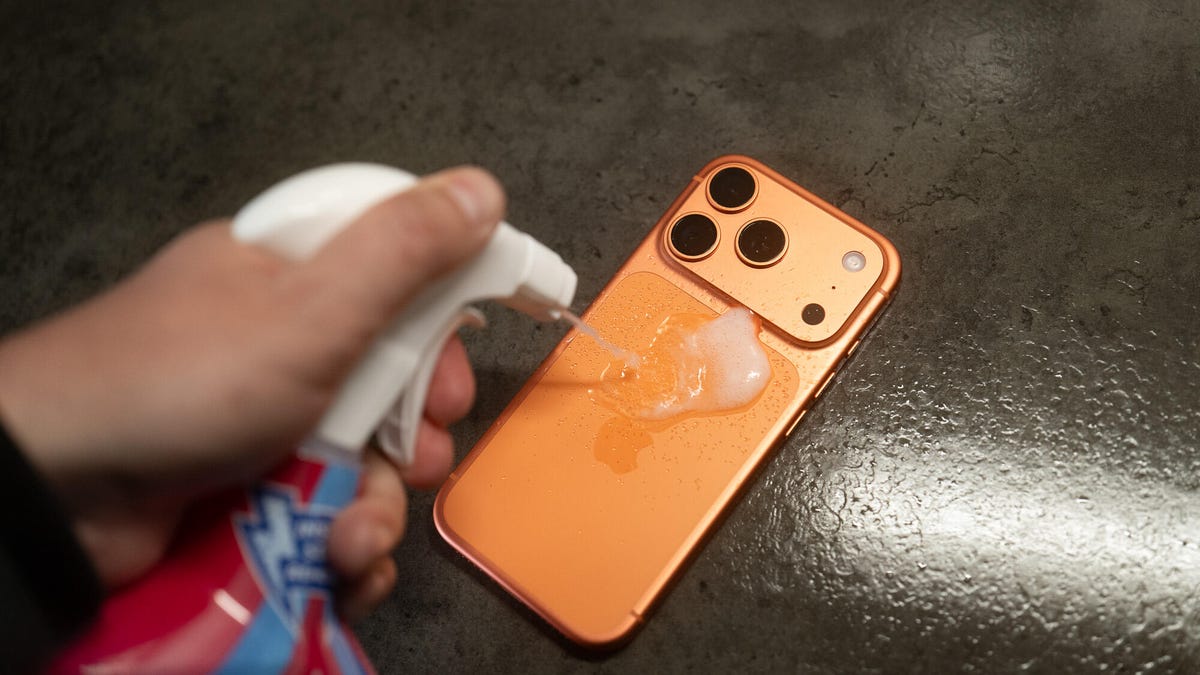
A recent Reddit thread suggests that it’s possible for a cosmic orange iPhone 17 Pro to turn vibrant pink. As PCMag’s Eric Zeman noted, it’s likely that the phone has been discolored by cleaning substances that affected the finish, turning it from vibrant orange to a wild hot pink. Sure, this might technically be a fault, but in all honesty I love pink phones and the idea of a hot pink iPhone 17 Pro filled me with joy. So I wanted to see if I could test the theory and see just what color-changing effects various household cleaners might have on my phone.
It’s important to note here that the iPhone 17 Pro I used was bought by CNET for the purposes of testing. Had I paid over $1,000 of my own money I wouldn’t be so reckless in smearing it with chemicals that could potentially irreparably harm it. And you shouldn’t either. If you need to clean your phone, do it safely. Disclaimer aside, let’s dive in.
The chemicals
I bought two chemicals to test this out. Zeman explains that it may be oxidation that caused the color to change and that hydrogen peroxide could do this. I couldn’t find this over the counter in the UK, so I instead bought an «oxy-active» stain remover spray that, among other things, contains «oxygen-based bleaching agents» which sounded ideal. Apple also clearly states «don’t use products containing bleach or hydrogen peroxide» on its support page so, naturally, I bought some thick bleach too.
Oxy application
I started by spraying the oxy cleaner on a microfiber cloth until it was noticeably wet from the liquid and then liberally applied this all over the rear of the iPhone. The Reddit user with the affected phone showed that it only affected the metal parts, not the glass back panel, so I made sure to focus my attention on the sides and camera bar.
With the phone well and truly doused in chemicals that have no business being anywhere near a phone, I left it to sit and think about what it had done for 30 minutes — after which time I wiped it dry and took a close inspection. Disappointingly, my phone was still factory orange, rather than «what the hell have you done to your phone» pink. Time to move on.
Bleach blast
I opened the bleach and trying hard not to think about my days as a middle school cleaner, applied a liberal blob of the stuff to a cloth and smeared it over the defenceless phone, concentrating again on the metal areas. I definitely should have worn protective gloves for all of this so please make sure you take better care of yourself than I do if you do anything with bleach.
Again, I gave it a 30-minute settling in period before cleaning it off and inspecting the results.
The phone remained as orange as ever, looking as box fresh as it was the day before when it was, indeed, box fresh. The orange color hadn’t changed and now almost 24 hours later there’s still no sign of discoloration of any kind.
Is the pink iPhone 17 real?
I can’t say with any certainty whether the Reddit user’s images of a pink iPhone 17 Pro are real or not. The cuddly human side of me wants to take them at their word, while the journalist in me is sceptical. What I can say with certainty is that putting your orange iPhone into close contact with household cleaning products isn’t going to win you a funky, ultra-rare pink hue that you could sell on eBay for a small fortune.
It’s possible that using pure peroxide could be the thing that does it, but to be honest, if you’re going out of your way to throw industrial-grade chemicals at your phone then you may as well just directly try and dye it. My goal here was to see how susceptible the orange model is to everyday household cleaners such as kitchen cleaner or bathroom bleach — the sort of things it might naturally come into contact with in routine use. And what I’ve found is that, no, it won’t ruin the nice orange color. But it’s probably still not good for your phone.
Technologies
My Teen Loves Her Apple AirPods Pro 2 and You Will Too With This $100 Off Deal for Black Friday
Apple’s AirPods Pro 2 have everything you could want from a pair of wireless earbuds, plus a steep discount.

Black Friday deals: The Apple AirPods Pro 2 are some of the best personal audio gear on the market, even if they aren’t the latest model anymore. Sure, Apple’s AirPods Pro 3 are the newest earbuds in the lineup but the AirPods Pro 2 are still an excellent pick for most people.
They’re an even better buy this week during early Black Friday sales when you can get your hands on a pair of Apple AirPods Pro 2 at a discount. Right now, Walmart is shaving a massive $100 off the AirPods Pro 2, dropping the cost to $139. That’s one of the lowest prices we’ve seen — but we doubt this deal will stick around for long.
Don’t miss any of our unbiased tech content and lab-based reviews. Add CNET as a preferred Google source.
HEADPHONE DEALS OF THE WEEK
-
$248 (save $152)
-
$298 (save $131)
-
$170 (save $180)
-
$250 (save $200)
CNET’s key takeaways
- You can get these amazing earbuds for just $139 right now at Walmart.
- My teenager loves everything about them.
- The sound quality is exceptional.
- The noise cancellation can help give you some peace, even in a busy home.
My 13-year-old daughter loves her music and her privacy, and for years she has wanted a pair of AirPods. They’re not cheap so I’ve only been getting her more budget options, like the Amazon Echo Buds, as a result. These kept seemingly disappearing, though, so I finally ponied up for the AirPods Pro 2.
I picked them up during last year’s sales, and they were definitely well-received. She’s happy, she uses them every day, and she hasn’t lost them yet. The AirPods Pro 2 are currently on sale at Walmart for $139, a nice price for a high-quality pair like these, and one of the lowest we’ve seen.
What about the AirPods Pro 3?
The AirPods Pro 3 weren’t available at the time I bought the AirPods Pro 2, but they were rumored, and I didn’t wait to see what they offered. As CNET’s resident headphone expert, David Carnoy summarized in his AirPods Pro 3 and Pro 3 comparison, the newer model is «significantly improved in the four most important areas: fit, sound quality, noise cancellation and battery life.» They also have heart-rate monitoring, like the Beats Powerbeats Pro 2.
Hey, did you know? CNET Deals texts are free, easy and save you money.
While these are undoubtedly all important things, a lot of people aren’t going to notice the differences or make the most of the new features. With the AirPods Pro 3 being newer, they’re on a smaller sale and are currently available at Amazon for $220, which is $30 off the list price.
Why I didn’t get the AirPods 4 instead
Why did I choose AirPods Pro 2 instead of the AirPods 4 with ANC? First, as I mentioned in another article about a different pair of earbuds I bought, I think sealed, in-ear buds are better than open-design models like the AirPods 4. The seal creates another layer of noise isolation and contributes to superior sound quality, and if you want to pay attention to the world you can always engage ambient sound mode, which Apple calls transparency mode.
Also a factor was that, at the time, Carnoy considered the Pro 2 the best Apple noise-canceling wireless earbuds: «While we’re quite impressed with those new models — and with the AirPods 4 ANC in particular — the AirPods Pro 2 remain arguably the best Apple AirPods you can buy if you don’t mind having silicone ear tips jammed in your ears,» he said.
My daughter uses earplugs all the time to help her sleep, so she definitely qualifies as somebody who’s comfortable stuffing things in her ears. Like her fingers, when I start using words like «sigma,» «skibidi» and «relatable» to try to relate to her.
I asked Carnoy about the Pro 2s potentially not fitting in her kid-size ears and he reassured me that the range of eartips that come with the Pro 2s «now include XS, so they should fit.»
Do AirPods make a great gift?
It took me years to finally understand, but yes, for someone looking for wireless earbuds, AirPods — especially the Apple AirPods Pro 2 — make the perfect gift, regardless of whether you’re a teenage girl.
Join Our Daily Deals Text Group!
Get hand-picked deals from CNET shopping experts straight to your phone.
By signing up, you confirm you are 16+ and agree to receive recurring marketing messages at the phone number provided. Consent is not a condition of purchase. Reply STOP to unsubscribe. Msg & data rates may apply. View our Privacy Policy and Terms of Use.
Technologies
If You’re Flying for the Holidays, This Bluetooth Dongle Transforms In-Flight Movies, and It’s 35% Off for Black Friday
Watch airplane movies just like you would at home with this game-changing device.
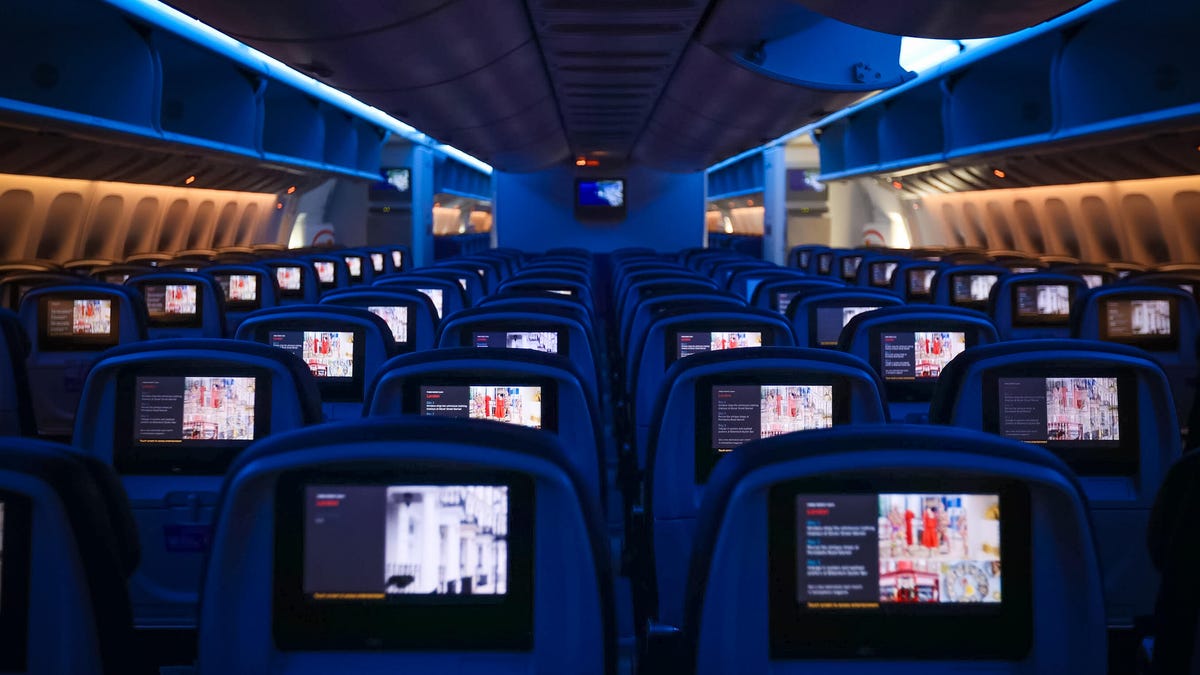
Air travel for the holidays can be stressful, especially when winter weather or flight delays force a change of plans, but one perk of flying still remains — watching new-release movies. However, in-flight entertainment on most airlines usually requires a wired set of earbuds. (And the ones the airline hands out are so bad they may as well not even be connected.)
I’d far prefer to use my wireless, noise-canceling AirPods Pro, but they connect only via Bluetooth. There’s a simple tech solution that makes viewing movies on the plane feel more like watching them on your couch.
The AirFly is a simple Bluetooth dongle that allows me to connect my wireless earbuds directly to the airplane’s entertainment system, eliminating the need for adapters or wired workarounds.
It’s become a must-pack item in my travel bag. Since I started using it, I’ve stopped dreading in-flight audio and finally get to enjoy movies on the plane. If you fly often, this little gadget could completely change how you travel. And the base level AirFly SE is 35% off for Black Friday at Amazon.
The AirFly Pro lets me enjoy in-flight entertainment
The AirFly Pro from Twelve South is a minimally designed dongle that allows me to connect to the 3.5mm headphone jack in my airplane seat, enabling me to listen to in-flight entertainment on my noise-canceling earbuds.
All I have to do is pair the AirFly with the Bluetooth headphones I’m using, such as my AirPods Pro, plug the AirFly into the display in front of me, and I’m all set. I don’t even need to use my phone to connect the two devices.
There are several versions of the AirFly: the AirFly SE, which is currently on sale for $26 on Amazon and connects to just one set of headphones, the AirFly Pro at $55, the Pro V2 at $60 and the Pro 2 Deluxe at $70, which comes with an international headphone adapter and a suede travel case.
Hey, did you know? CNET Deals texts are free, easy and save you money.
I use the AirFly Pro, which has been a game-changer for me on flights. I’ve never had to worry about battery life since the AirFly Pro lasts for over 25 hours and can be fully charged in just three hours. I can also pair two separate pairs of headphones to a single AirFly Pro, in case I’m with someone else on a flight and want to watch the same movie or show.
And if that’s not enough, the AirFly Pro also doubles as an audio transmitter, allowing me to turn any speaker with a headphone jack, such as my old car stereo, into a Bluetooth speaker.
The AirFly Pro makes a great gift for any traveler
The AirFly Pro is the perfect present to give to someone who’s planning to travel this year. Besides my Anker MagSafe battery pack, the AirFly Pro has become my most treasured travel accessory when I fly, which is why I consider it one of those can’t-go-wrong gifts.
For more travel gear, here are our favorite tech essentials to travel with and our favorite travel pillows.
Join Our Daily Deals Text Group!
Get hand-picked deals from CNET shopping experts straight to your phone.
By signing up, you confirm you are 16+ and agree to receive recurring marketing messages at the phone number provided. Consent is not a condition of purchase. Reply STOP to unsubscribe. Msg & data rates may apply. View our Privacy Policy and Terms of Use.
-

 Technologies3 года ago
Technologies3 года agoTech Companies Need to Be Held Accountable for Security, Experts Say
-

 Technologies3 года ago
Technologies3 года agoBest Handheld Game Console in 2023
-

 Technologies3 года ago
Technologies3 года agoTighten Up Your VR Game With the Best Head Straps for Quest 2
-

 Technologies4 года ago
Technologies4 года agoBlack Friday 2021: The best deals on TVs, headphones, kitchenware, and more
-

 Technologies4 года ago
Technologies4 года agoVerum, Wickr and Threema: next generation secured messengers
-

 Technologies4 года ago
Technologies4 года agoGoogle to require vaccinations as Silicon Valley rethinks return-to-office policies
-

 Technologies4 года ago
Technologies4 года agoOlivia Harlan Dekker for Verum Messenger
-

 Technologies4 года ago
Technologies4 года agoiPhone 13 event: How to watch Apple’s big announcement tomorrow



